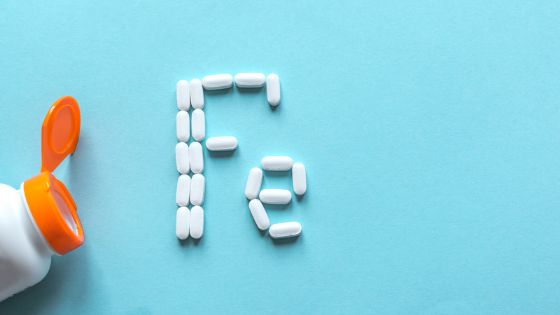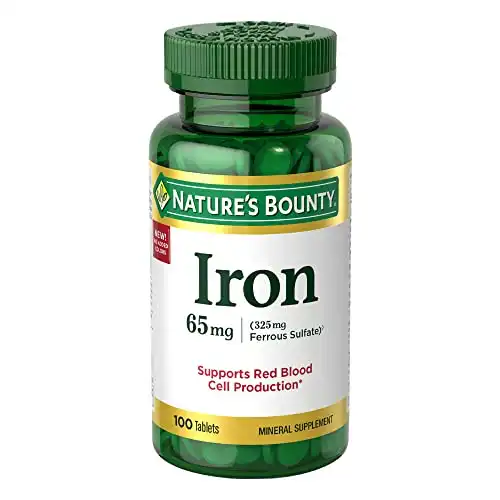What is a normal iron level for a woman? (Everything You Need To Know)

What is a normal iron level for a woman? The standard hemoglobin range for women typically falls between 11.6 to 15 grams (g) per deciliter (dL) of blood.
Hemoglobin is a protein in red blood cells that carries oxygen throughout the body and helps keep us healthy. Iron levels are typically measured by taking a complete blood count (CBC) test.
If your iron level falls below 11 g/dL, it may indicate anemia caused by either low iron intake or poor absorption from food sources.
- What is Iron, and Why Is It Important for Women's Health?
- Recommended daily iron intake for women by age
- The Difference Between Normal and Low Iron Levels
- Signs of Low Iron in Women
- How to Increase Your Iron Level Naturally
- When to See a Doctor About Your Iron Level
- Tips for Maintaining Healthy Blood-Iron Levels
- Final words
What is Iron, and Why Is It Important for Women's Health?
Iron is essential in all living organisms and is necessary for many of the body’s metabolic processes.
It is also a key component of hemoglobin, which carries oxygen to all body parts. For women, iron is especially important for health due to its unique physiology and lifestyle needs.
Function
Iron helps maintain normal red blood cell production, which is essential for transporting oxygen throughout the body and fighting fatigue.
Women are more prone to the iron deficiency than men due to monthly menstrual bleeding, which can lead to anemia by depleting the body’s iron levels.
Low levels of iron can result in feelings of tiredness, weakness, dizziness, difficulty concentrating, and other health issues.
Dietary Allowance
The daily recommended dietary allowance (RDA) for adult women aged 19–50 is 18 milligrams (mg) per day; pregnant women should consume 27 mg daily.
The best way to increase your iron intake is by eating foods naturally high in this mineral, such as beef, poultry, fish, legumes, and leafy green vegetables like spinach and kale.
Iron-fortified cereals and grains can also be beneficial. Eating foods with Vitamin C (like citrus fruits or peppers) alongside these items can help you absorb more iron from these sources.
Supplements
It’s important to note that supplementing with iron may benefit those suffering from anemia or any other condition resulting from low levels of this mineral.
Excessive amounts can cause toxicity, so it’s best to consult a doctor before taking any supplements.
Additionally, some medications (e.g., antacids) may interfere with the absorption of iron or make symptoms worse if taken at the same time as supplements or fortified food products containing this mineral.
It is important for women who may need more iron to speak with their doctor before taking any iron supplements.
This is because there may be potential interactions with medications they are already taking. A healthcare professional will be able to prescribe the best treatment options.
You may be interested in "Top 10 Iron-Rich Foods For Anemia: Cure Your Iron Deficiency Fast!"
Recommended daily iron intake for women by age

Here is a table showing the recommended daily iron intake for women by age:
| Age | Recommended daily iron intake (mg) |
|---|---|
| Adolescents (girls) 14 to 18 years of age | 15 |
| Pregnant adolescents | 27 |
| Pregnant women | 27 |
| Adult females 19 to 50 years of age | 18 |
| Adults females 51 years of age and older | 8 |
Note: Therefore, it's essential to consult with a healthcare provider to determine your specific nutrient needs.
It's also worth noting that the recommended daily intake of iron can vary depending on factors such as your overall health, lifestyle, and diet. Therefore, it's essential to talk to a healthcare provider or a registered dietitian to determine the appropriate amount of iron for you.
The Difference Between Normal and Low Iron Levels
The difference between normal and low iron levels is an important distinction to make in regard to overall health.
Our bodies need to have sufficient iron levels, as it plays a critical role in the production of hemoglobin - a molecule found in red blood cells which transports oxygen throughout our body.
A person's iron level can be determined through a simple blood test. Normal levels of iron are typically considered to range from 12-17 milligrams per deciliter (mg/dL).
Low iron levels, otherwise known as anemia, occur when these values drop below 12 mg/dL.
Anemia
Many factors, including nutritional deficiencies, bleeding disorders, certain diseases, and medications, can cause anemia.
When anemia occurs due to poor nutrition or other lifestyle factors such as smoking, it is referred to as dietary or nutritional anemia.
Other common causes include heavy menstrual bleeding, chronic diseases such as kidney disease or cancer, and some medications such as antibiotics or anti-inflammatory drugs.
Dietary changes
If your doctor does diagnose you with low iron levels or anemia, they will likely recommend dietary changes that include increasing consumption of foods rich in iron such as red meat, dark leafy greens like spinach and kale and dried fruits such as raisins and apricots.
Additionally your doctor may also suggest taking over-the-counter supplements that contain iron or even prescribing you prescription supplements that contain higher doses of the mineral depending on the severity of your condition.
Excess of iron in the body
It's important to note that having too much Iron can also be harmful so it's essential to speak with your doctor before increasing your intake of any Iron containing food sources or supplements.
By maintaining healthy Iron levels through diet and lifestyle changes along with regular medical checkups it’s possible to avoid many serious health complications associated with low Iron levels or Anemia!
Signs of Low Iron in Women
Signs of Low Iron in Women can be quite varied and subtle. The most common symptom is fatigue, as iron is a key component in the production of hemoglobin which carries oxygen throughout the body.
Other symptoms include shortness of breath, pale skin, weakness, headaches, dizziness, irritability, frequent infections, and an increased heart rate.
Some women may also experience cravings for non-nutritive substances such as clay or ice.
Other symptoms
Iron deficiency can also manifest in changes to the nails; they may become thin, brittle and easily broken with spoon-shaped indentations along the surface known as koilonychia.
The mouth may appear pale due to a decrease in red blood cells affecting the tongue and inner lining of the cheeks.
Those with low iron levels are at an increased risk for developing anemia - a condition characterized by a decrease in red blood cells leading to inadequate oxygen delivery around the body.
A decrease in iron stores can also weaken the immune system making it difficult for the body to fight off illnesses leading to frequent colds and other infections.
Women who are pregnant or have experienced heavy periods are particularly prone to developing low iron levels which can lead to more serious issues such as poor fetal growth and premature birth if not addressed promptly.
How to identify signs of low iron levels
The best way to identify signs of low iron levels is through a simple blood test which will measure your ferritin level - storage form of iron found within cells - that indicates how much of this nutrient you have available within your body.
If ferritin levels fall below twelve nanograms per milliliter then treatment should begin immediately with oral supplementation or intravenous therapy if necessary.
It's important to note that even if symptoms aren't present yet, treatment should still be considered if ferritin levels drop below normal range since further deficiencies can cause long-term health problems down the road.
How to Increase Your Iron Level Naturally
Low iron levels are a common issue among women, especially those who experience heavy menstrual flow, are pregnant, or are vegetarians or vegans.
It’s important to take steps to increase your iron level naturally and avoid the potential side effects of taking iron supplements. Let’s explore some of the best ways to get your iron levels back up naturally.
Eat Iron-Rich Foods
The most natural way to increase your iron level is to focus on eating foods that are high in iron. Examples include red meat, shellfish, beans, fortified cereals and grains, dark leafy greens like spinach and kale, and dried fruits such as raisins and apricots.
Eating foods that are rich in vitamin C can also help your body absorb more iron; good sources of vitamin C include oranges, grapefruits, peppers, tomatoes, strawberries and kiwi.
Take an Iron Supplement
If you find that you’re not getting enough iron from your diet alone (or if you simply don’t have the appetite for it), consider taking an over-the-counter iron supplement once a day with meals or under the direction of a doctor.
Taking an iron supplement can also help replace lost nutrients during heavy menstrual periods or pregnancy.
However, it is important to consult a doctor before taking any supplements since too much iron can be harmful for your health.
Stay Hydrated
Ensuring that you stay hydrated throughout the day can also help boost your energy levels by helping your body absorb more nutrients—including iron—from the food you eat.
Drinking at least 8 glasses of water per day will ensure that you maintain adequate hydration levels throughout the day and will prevent dehydration from setting in which can worsen fatigue symptoms associated with low hemoglobin levels due to low dietary intake of iron-rich foods.
When to See a Doctor About Your Iron Level
It is important to be aware of your body’s iron levels, as it plays a vital role in keeping you healthy. Having too much or too little iron in the body can cause serious health problems.
If you think your body might be low on iron, it is important to see a doctor for an evaluation and treatment plan.
A doctor will evaluate your symptoms and may order blood tests to determine if you are anemic. Symptoms of anemia due to low iron levels include fatigue, rapid heart rate, pale skin, shortness of breath, dizziness upon standing, brittle nails, headaches and chest pain. Additionally, a person may experience tingling or numbness in their hands and feet.
If you are experiencing any of these symptoms or if there is a history of family members having anemia due to low iron levels, then it is best to see a doctor for further testing. The doctor may also ask about dietary habits in order to get a better understanding of the patient's diet and ensure that they are getting enough essential nutrients from the foods they eat.
Tips for Maintaining Healthy Blood-Iron Levels
Iron is an essential mineral for the body, and it's especially important for women. Not only does iron help with cell regeneration and energy production, but a lack of iron can lead to anemia and other health issues.
To keep your blood-iron levels balanced, here are some tips that every woman should keep in mind.
Eat Healthy Foods
Foods like dark leafy greens, lean red meats, beans, nuts, eggs, and fortified cereals are all good sources of dietary iron. Eating a balanced diet can help you get enough iron naturally.
Additionally, vitamin C helps to increases absorption of dietary iron in the body. So be sure to include foods rich in Vitamin C such as citrus fruits and bell peppers into your diet as well.
Take Supplements
If you’re having trouble getting enough iron through food alone, consider taking an iron supplement.
Supplements provide concentrated amounts of the mineral that can help you reach your daily goal without having to cram too many spinach salads into your diet!
However, be sure to speak with your doctor first about what type of supplement is best for you—there are multiple forms and doses available so it’s important to find one that works for you.
Watch Out For Blood Loss
Blood loss from heavy periods or childbirth can cause low levels of iron in the body. If you have very heavy periods or regularly experience any other form of bleeding or injury, be sure to talk to your doctor about how much additional iron intake may be necessary for you.
Maintaining healthy blood-iron levels is essential for women's health and wellbeing. Eating a balanced diet with plenty of iron-rich foods and considering taking a supplement if needed are two great ways to ensure that your body has enough iron throughout the day. Additionally, if you experience any form of regular blood loss, consulting with a doctor about additional measures may be necessary as well. With these tips in mind, women everywhere can take charge of their own health by ensuring they have proper amounts of this essential mineral each day!
Final words
Iron is an essential mineral for our health, and it’s important to make sure that you’re getting enough of it.
Eating iron-rich foods and taking supplements if necessary can help ensure that your body has the right amount of this important mineral.
Additionally, be aware of any blood loss in order to determine if additional iron intake may be needed. With these tips in mind, you can stay healthy and keep your levels balanced!
DISCLAIMER: buildyourbody.org does not provide medical advice, examination, or diagnosis.
Medically reviewed and approved by Nataniel Josue M D.


